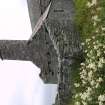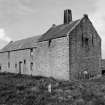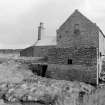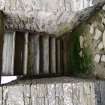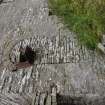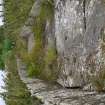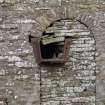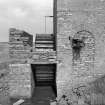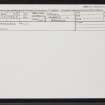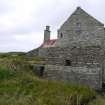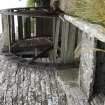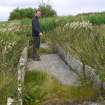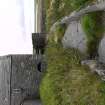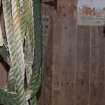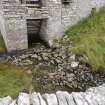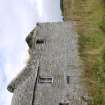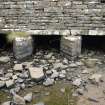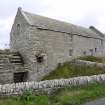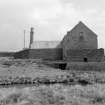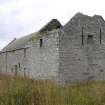Tankerness Mill
Grain Mill (19th Century)
Site Name Tankerness Mill
Classification Grain Mill (19th Century)
Alternative Name(s) Mill Of Tankerness
Canmore ID 3015
Site Number HY50NW 53
NGR HY 51451 08549
Datum OSGB36 - NGR
Permalink http://canmore.org.uk/site/3015
- Council Orkney Islands
- Parish St Andrews And Deerness
- Former Region Orkney Islands Area
- Former District Orkney
- Former County Orkney
HY50NW 53 51451 08549
(Location cited as HY 515 085). Tankerness Mill, early 19th century. A two-storey and basement rubble range on a T- plan, with a large kiln. The three pairs of stones were driven by a high-breast wheel about 14ft (4.3m) diameter. The wheel is in a roofless house, said to have been built to conceal it from passing horses. Disused but intact.
J R Hume 1977.
2-storey, 5-bay T-plan asymmetrical mill with slightly raised kiln at E end and undershot water wheel at W. Harl-pointed rubble. Long and short quoins to kiln. The tall blocked arches mark the position of the original wheel before it was placed on the outside of the end wall.
3 pairs of stones were driven by a high-breast wheel about 4.3m in diameter and, in order that the movement of the wheel did not startle horses passing over the adjacent bridge, it was shielded by a screen wall.(Historic Scotland)
Publication Account (1977)
(Location cited as HY 515 085). Tankerness Mill, early 19th century. A two-storey and basement rubble range on a T- plan, with a large kiln. The three pairs of stones were driven by a high-breast wheel about 14ft (4.3m) diameter. The wheel is in a roofless house, said to have been built to conceal it from passing horses. Disused but intact.
J R Hume 1977.
Field Visit (24 October 1981)
Tankerness Mill is an early 19th century meal mill, built on a 'T'-plan., with a large and prominent revolving kiln ventilator. It consists of a two-storey and basement building with a flagstone roof, the northern leg of which is a dwelling which was added to the original mill around 1900. The external waterwheel, which is at the eastern end of the mill building, is surrounded by a roofless stone enclosure...The mill had ceased operations by 1961, but remains intact.
When in use, the mill was driven by an iron and wood high-breast water wheel measuring 3.6m (outside diameter) by 1.22m in width. The two outer rings and sets of eight arms are of cast iron, and housed 32 wooden buckets. The present wheel replaces an earlier wheel originally inside the mill. Ordnance Survey maps indicate that this change occurred around 1902. Evidence of the previous location of the waterwheel is provided by the arched openings (now blocked) in the SE corner (south wall) of the mill building, and by the existence of a former wheel pit inside the building. The current wheel drove three pairs of millstones, which were used to produce bere and oatmeal, as well as animal feed.
There are a number of unusual features of this mill that are worth noting. In particular, a sluice at the head of the 'Mill Burn' 300m from the mill could be operated from the mill, permitting greater control of the water flow. Also of interest is the sack hoist , which was taken from Papdale Mill in Kirkwall following its closure. The mill also possesses a flat pulley sytem allowing drive from a tractor to power a hammer mill - an advanced type of grain bruiser.
In the graveyard of St Andrews and Deerness can be found the gravestone of one of the last millers, Alexander Linklater, who died in 1953.
RCAHMS MS/500/35/31
Field Visit (30 July 2010)
The waterwheel and interior machinery appears to be more or less intact. The kiln roof has collapsed. The SW corner, S elevation and NW corner N elevation shows the blocked arches to the orginal interior waterwheel. The remains of the pulley wheel for the tractor driven hammer mill described in RCAHMS MS/500/35/31 is visible, although the pulley wheel has been lost since 1981.
Visited by RCAHMS (MMD/IA), 30 July 2010.
































